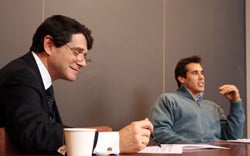Negotiating multi-million dollar, multi-year contracts with sports teams, navigating the inner-workings of complex and frequently extremely lucrative endorsement deals, and maintaining the public image of an athlete are all part of the job for Cleveland Browns Quarterback Brady Quinn – and that’s not even mentioning the regular pressure of performing in a sport that requires its players to stand back up after being knocked over by 350-pound linemen after every snap of the ball.
This January, Quinn brought his expertise to the Harvard Law School classroom as a guest in Lecturer on Law Peter Carfagna’s course “Representing the Professional Athlete.” Through a frank two hour question-and-answer session, students got an inside look at the numerous behind-the-scenes negotiations that are a part of every athlete’s career.
“Brady Quinn … spoke to, how do my performance bonuses relate to my contract, for example,” said Carfagna. “It’s the kind of thing that I can teach and that I know, but when you hear him say that—and he’s got a boot on his foot, and he’s hurt so he couldn’t reach his bonuses this year—I think it brings it home to the students in a way that I can’t when you’re talking about it more or less in a vacuum.”
Quinn was just one of the many professional athletes, world-class sports agents, and members of the management staff of various teams and leagues Carfagna has welcomed into the classroom. The guest roster for his course reads like a veritable who’s-who of the sports management world: the agents for golfer Vijay Singh and for tennis player Roger Federer; representatives from the Boston Red Sox, the Boston Celtics, the Florida Marlins, and the Cleveland Indians; and tennis player Mario Ancic, just to name a few.
The high-profile guest lectures, which are a valuable starting point for discussing some of the issues at stake in the field of sports law, only make up half of the course, however. For the remainder of the class, students work together in small groups to draft hypothetical contracts and to conduct a mock litigation argument, including the drafting of deposition questions and legal briefs.
“Working at a firm this summer, it became clear just how much I had learned about drafting because I was already able to read and understand contracts in a way that many law students only learn in practice,” said Elizabeth Rich ’10, who took the course last year and worked with Carfagna as one of two student teaching assistants during this year’s class.
The emphasis on class participation is a unique aspect of the course that the students appreciate. Not only are students required to complete in-group assignments on a weekly basis, but they are also required to report on their group’s work during the class.
Carfagna also invites students to join the teaching staff as assistants who are responsible for helping to create the syllabus, review assignments, monitor group work, and keep up with current events and incorporate them into the class.
“It [being a TA] really solidified what I had learned in the class and gave me the ability to look critically at the work my own group had put out last year as well as at the assignments the students turned in regularly throughout this year’s course,” said Rich of her experience working as a teaching assistant. “By taking the course I learned to draft, but by TAing, I learned to look at drafts critically to see where the loopholes are and what loose ends still need to be tied.”
Ryan Gauthier ’10, another student teacher this year who hopes to pursue a career in sports law, explained what it was like to work closely with Carfagna: “Working with Professor Carfagna can be demanding, but in a positive way. He expects a lot out of his TAs, but he is also willing to put in just as much, if not more, effort. There is a lot of responsibility placed upon TAs, which can be daunting, but is also really encouraging.”
“Representing the Professional Athlete” is only one of a suite of courses offered by Carfagna, who since joining the HLS faculty as a lecturer, has built a strong sports law program that now includes three course offerings; a clinical component, which places students in externships with sports teams and in league offices; and two student-run organizations: the Committee on Sports and Entertainment Law and the Journal on Sports and Entertainment law, both of which Carfagna oversees as faculty advisor.
Instruction in sports law is important, Carfagna says, because it’s a growing industry that requires expertise across a broad range of issues, including contract law, negotiation, and labor law.
Said Carfagna: “There are careers for many of them [my students] because we’ve expanded to the point where careful lawyering – which is what I really teach – is critical to the success of the entire enterprise.”
